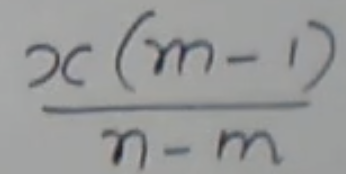eddy2017
Elite Member
- Joined
- Oct 27, 2017
- Messages
- 2,525
The following is a shortcut in case you get a problem like this type and you are taking a timed test. (Timed tests are the order of the day!).I am bringing it to the forum to ask tutors if they think this may apply to different varieties of age problems. Don't know what the formula would be if instead of 'after.... ' we have '_____ago'
Ram is 3 times as old as Shyam. After 15 years Ram will be twice as old than Shyam. Find their current ages.
First condition: After 15 years= x, x=15
Second condition: Ram will be twice as old=m, m= 2
Third condition(the n condition)= 3 times as….as, n=3
who is the youngest = Shyam ( if you have Shyam's age you only will need to multiply by 3 to get Ram's
formula to find the age of the youngest person
[math]x(m-1)/n-m[/math]
Sustituye valores
15(2-1)/3-2
15(3)/1
=15 Shyam is 15 yrs old
Ram is 3 times as old as Shyam, so
3(15)= 45; Ram is 45 yrs
thanks,
eddy
Ram is 3 times as old as Shyam. After 15 years Ram will be twice as old than Shyam. Find their current ages.
First condition: After 15 years= x, x=15
Second condition: Ram will be twice as old=m, m= 2
Third condition(the n condition)= 3 times as….as, n=3
who is the youngest = Shyam ( if you have Shyam's age you only will need to multiply by 3 to get Ram's
formula to find the age of the youngest person
[math]x(m-1)/n-m[/math]
Sustituye valores
15(2-1)/3-2
15(3)/1
=15 Shyam is 15 yrs old
Ram is 3 times as old as Shyam, so
3(15)= 45; Ram is 45 yrs
thanks,
eddy


